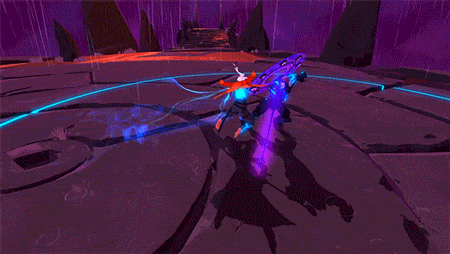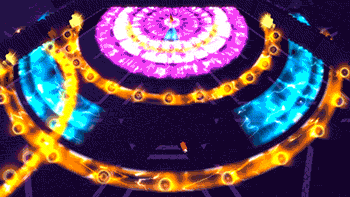
Featured Blog | This community-written post highlights the best of what the game industry has to offer. Read more like it on the Game Developer Blogs or learn how to Submit Your Own Blog Post
Furi: some tough design decisions striving to make a memorable game
Following the launch of Furi - the boss rush game for PC/ PS4 - Emeric Thoa is sharing thoughts on some of the hard design decisions behind making a game that's not meant to please everyone but strives to create strong memories for its intended audience.

Emeric Thoa is Creative Director and Co-Founder at The Game Bakers, the studio behind Furi, Combo Crew, or the Squids games on console, PC and mobile. This post is reposted from The Game Bakers blog. Follow The Game Bakers: @TheGameBakers / @EmericThoa
Furi is a character action game for console and PC in which you fight only bosses. You can get an idea of what the game is about with this trailer: Furi Trailer.
*****
We launched Furi and received a truly incredible response from some players: they are crazy about the game, they love it more than I could have ever dreamt. In the meantime, other players, some reviewers didn't enjoy the game or felt rejected by it. And they criticized the game for that. That’s pretty fair, but here is a thing. Not every game is for you. That’s what is called diversity. That’s a good thing (Ken Wong explains it better than I would ever do).
Of course, there are games that are bad or average. They missed something and very few people actually love them. But I don't think it's the case for Furi. As it was very well summed up in some reviews, Furi is a love-hate kind of game. And believe it or not: it’s by design. It’s a game that was designed to create intense satisfaction, and it succeeded in doing so, even if it frustrated some along the way.

Furi is a Love-Hate game
In this article, I’ll explain how we came up with this intention, and how we made it happen.
PART ONE: On making a game that doesn’t try to please everyone.
After we made Combo Crew on mobile, my partner Audrey and myself started thinking about what our next game could be. We were in 2013. Indie gaming was already big, but we knew it would grow bigger. We knew the market would be even more saturated, even more fragmented. We knew that, by 2016, iOS and Google Play would be nothing like in 2010. Steam would be flooded by releases every day, and even the very young new consoles (PS4 and Xbox One) would have their stores full of games and sales of any kind.
We realized that, in order to be in the top 10 of the indie devs, we needed to make something « outstanding ». A game that stands out, in every possible way. A game with an edge. A game that I call a « Triple i » or “iii”.
 This picture was in the very first document for Furi
This picture was in the very first document for Furi
Triple AAA games have the budget, the talents, the teams to achieve greatness with a huge scope. Story, visuals, characters, gameplay features, game modes, game length… they try to have everything in order to please everybody. Their aim is mass audience.
We believed that, in order to be competitive, smaller studios must go the opposite way. We are too small to be the best at everything, but we can aim to be the best at one thing. We can make something edgy. We can choose not to please everybody. We can choose to make something that most would actually dislike, in order to make sure a niche of gamers will find it truly memorable.
This was the foundation of our strategy for the three years to come.
"I don't know the key to success, but the key to failure is trying to please everybody."
Every decision in Furi was made in order to make it memorable for a niche of gamers who were somewhat starved: the Japanese character action game fans. Every decision was made in order to make the game outstanding, unique and focused.
The art direction stands out, with colourful and surrealistic environments.

The character design is stylish and unique, as we can expect from Afro Samurai’s creator Takashi Okazaki.

The combat is (very) fast paced, inspired by Japanese game design.

Its use of both shoot’em up and beat’em up mechanics is totally unique.

The soundtrack is made up of original compositions from amazing electro and synthwave musicians.

If we compare with the direction taken by a recent mainstream beat’em up like God of War, it's clear to see we just went the opposite way. They go for realism, we opted for surrealism. They went for an orchestral soundtrack, we decided on electro. Let’s not fight head to head with these guys, right?

They aimed for mass appeal, we didn't. No compromises. No consensus. We developed a game for a niche audience, but with the intention on casting a spell on our fans forever.
PART TWO: On fighting half-measures. On making strong choices.
This is a bold strategy to start with, but it’s even harder to make it actually happen. Especially during two years of production where as a creative director you are constantly challenged, by the team, by the playtesters, by the press in previews, by trailers comments… by anyone who is slightly involved in the game really.
I remember, during the heat of the production, tweeting this:

Any designer who reads me knows what I’m talking about. This fight against consensus, against half-measures, was the key to succeeding with this initial strategy of not trying to please everyone. If you go soft, you lose the edge, and then it’s over.
Here are some examples of the controversial decisions I took. Even some players who loved the game still disagree with them. I hear them. I’m not saying it couldn’t have been done otherwise or better. If I could, I would improve lots of things in the game, like the tutorials or the promenade mode. But I would probably stick with some of the controversial decisions I took, they are part of what makes Furi what it is.
Spoilers ahead.
Paths

In Furi, in between each fight, there are walking sequences where you just get backstory and coaching by your rabbit-masked mysterious buddy. You discover a visually unique environment teasing the upcoming boss personality, and listen to the music. These sequences are important because they give a meaning to the game through the story, they build the tension, and they force the player to take a break in between two intense boss fights. I knew the most arcade-hardcore players wouldn’t like it, but for most of our audience, it took Furi from “a great game” to “a meaningful experience”. As a designer, we stood strong with the idea of having the player “walk” and even “autowalk” (there’s a button for that) for 3-4 minutes. No minions to fight. No experience points to grind. No loot. I bet you can imagine this was a tough call to keep for two years of development.

The secret ending that resets your save

At one point in the game, there is a disguised choice. You can basically stop fighting. Stop killing. Reach a status quo. There is no good ending in the game, they all are good and bad in some ways. There is no happy end. But at least, you can choose why you fight for, or if you want to fight at all.
It was important to me to make it “a true ending”. Otherwise it would have been a simple “easter egg”. Another trophy to the list. So I stood with the decision to reset the save after the players get that ending. Some people are annoyed because it makes them replay half of the game. Some people are annoyed because they triggered the ending accidentally (they are right to be annoyed, they are collateral damage of a strong design choice).
But this kind of moment:
- “I found a hidden event”.
- “Oh it’s an ending, a peaceful one in a game about duels”.
- “F*** my save is erased, they are not kidding, it’s actually over”.
It’s part of what Furi tries to deliver. Surprise, adrenalin, intense emotions. Some people ranted about it, but some understood and loved it.

No come back from Promenade difficulty level
The game has three difficulty levels. The default one (Furi level) is demanding, requires a lot of patience and perseverance, and delivers a great deal of satisfaction when beaten. The hard one (Furier) is an extremely difficult game mode with the patterns and boss fights redesigned. We know that players who finish this game mode love the game and understood it, otherwise they wouldn’t have been able to beat it. We actually thank them for that.

The last one (Promenade) is an extremely easy and shorter difficulty level for players who just don’t want to invest as much effort in the gameplay. Some players complain they can’t switch to Promenade for one fight and then come back to Furi mode. The reason we don’t allow this is not to punish players, it’s the opposite. If we did allow that, players would be tempted to switch to Promenade as soon as they encounter a difficulty peak. They would be tempted to go back and forth between the difficulty levels and they would lose all the satisfaction they'd get of eventually overcoming a big challenge.
Dashing on the “release”, a.k.a. the false perception of delay
In the game, there is a very fast, satisfying dodge ability, that makes you basically invincible. Some players have complained it was laggy or they felt a delay. There is no delay at all, but the dash starts when you “release” the button, not when you “press”. The reason for that is that you can charge the dash to go further. Press and hold, you charge. Release, you dash. This charging dash gives tons of depth to the patterns we can create. The boss fights get a lot of variety from this feature. But even within the team, this decision was considered very controversial. We could have split the dash ability on two buttons (quick dash/charged dash), but it felt too complex. Once you are used to a quick press & release for a dash (and most players are after one or two bosses), you get both the simplicity of the controls AND the gameplay depth.

These are only a few of the decisions that were controversial but that I decided to stick with instead of looking for a compromise. Of course, I DID change a lot of the design when I got complaints or relevant comments. I’m not saying it’s good to be narrow-minded. But it’s good to take some risks in order to keep your edge. I’m very grateful to Audrey and the core team at The Game Bakers and our partners at Sony for understanding that. They all committed to this vision from the start of the project.
PART THREE: On creating intense satisfaction.
The reason I love video games is because they create emotions. Through their gameplay, story, visuals, music, they can deliver any emotion you can think of.
Uncharted 4 delivers great brainless distraction, P.T. freaks you out, Journey creates a bond, Monument Valley makes you feel smart and poetic. Furi creates intense satisfaction. And by necessity, it can also create intense frustration along the way.

But I believe it succeeded creating intense satisfaction.

People say the game is hard. I would argue it’s mostly from another time. It’s anachronic. It requires patience (definitively not a trendy trait) and it’s a game of counter attack (a game where you wait and punish instead of aggressively attacking with combos, as in most games of the 2000's to current era).
But players who are perseverant will get better each time they play. Furi is like a guitar and each bossfight is like a partition. You start playing and you suck at it, but you get better after each practice. This is not something everyone is willing to do, but it makes it extremely satisfying when you finally beat a boss. This satisfaction is actually proportional to the effort you put into the bossfight. In order to create intense satisfaction, you need to require efforts.
And when the game manages to trigger that into someone, when a player finally overcomes the frustration and pain to turn it into relief and satisfaction, you get this:

The industry has a tendency to reward games that don’t itch. Metacritic rules us all, and the formula to get a high Metacritic score is to make a game with one good feature and no flaw. We are prompted to make games that don’t displease, games that don’t frustrate. But recently, I have seen more and more games trying to be edgy. Trying to create intense emotions, even if it’s at the risk of segregating themselves from a larger audience.
It’s exciting.
Let’s welcome that.
Read more about:
Featured BlogsAbout the Author(s)
You May Also Like







.jpeg?width=700&auto=webp&quality=80&disable=upscale)








